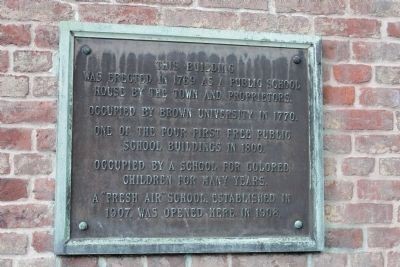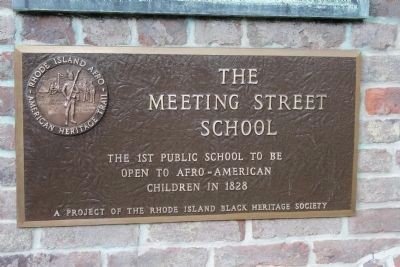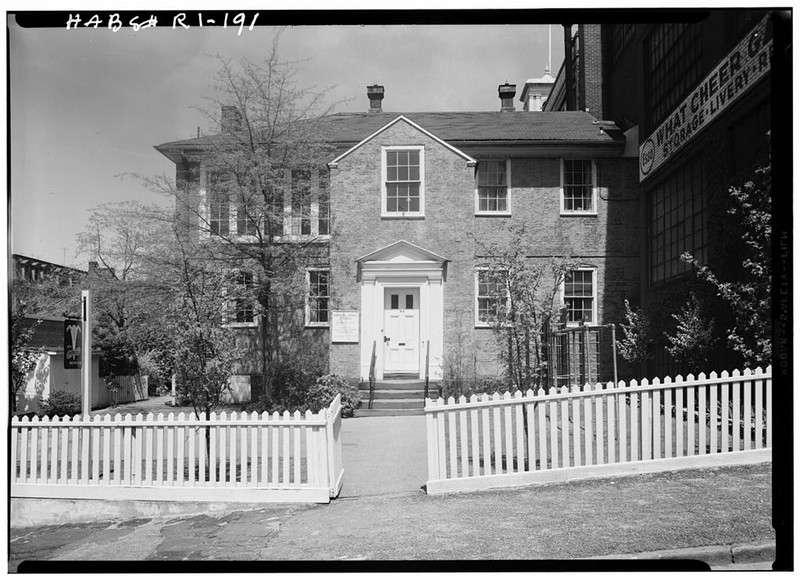Meeting Street School
Introduction
Text-to-speech Audio
Now the headquarters of the Providence Preservation Society, this historic building was the first brick school built in the city of Providence. The building was also used by Rhode Island College (Brown University today) and even served as an arsenal and temporary military hospital during the American Revolution. In 1800, education pioneer John Howland purchased the building and operated one of the first schools in the United States to be completely free and open to the public. In 1828, the school leaders decided to freely admit children of color, making this the first integrated public school in American history.
Images
Meeting Street School historic marker, erected by the state of Rhode Island (image from Historic Markers Database)

Meeting Street School historic marker, erected by the Rhode Island Black Heritage Society (image from Historic Markers Database)

The Meeting Street School (image from the Library of Congress)

Backstory and Context
Text-to-speech Audio
The Meeting Street School (also referred to as the Brick Schoolhouse) was the first brick school structure in the city of Providence and one of the first free schools in the United States. Originally, the two-story structure was intended to separate the free school (on the first floor) from the private school maintained by the "subscribers" or "proprietors" (on the second floor). When Rhode Island College (which in 1796 became Brown University) moved from Warren to Providence in 1770, college classes were temporarily held in the school house, and the school served as a meeting place for the committee in charge of deciding on a permanent location for the university.
During the American Revolution, the Meeting Street School served as a colonial arsenal and gunpowder manufactory from 1776-1784. When the British landed at Newport in 1776, Rhode Island College classes were suspended, and the official campus was used to house French allies and a temporary military hospital until 1782; the schoolhouse may have served, once again, as a refuge for the college during this time. In 1786, the University Grammar School. John Howland, often credited as the father of public school in America, pushed for a public school system, inspiring the city of Providence to purchase the Brick Schoolhouse outright and open as a free school in 1800.
In 1828, the Brick Schoolhouse became the first public school to admit African American children, with around 100 students in its care. Though attendance decreased by 1836, the building was enlarged in 1850, and a cooking school took up residence in 1865. In 1908, the Schoolhouse became the first American "fresh air" school for children with tuberculosis. For this purpose, the building's upper windows were enlarged, requiring the removal of bricks from the south facade. Around 1913, the building was used by the School for Crippled Children and Adults of Rhode Island, and from 1946-1957 served as the Meeting Street School for children with developmental disabilities (the institution outgrew the building, but continues to operate in Providence).
The Providence Preservation Society took over the building in 1960, and restorations (including changes to the altered windows) took place. The second floor of the schoolhouse is used as a meeting room and lecture hall, and the building serves as the headquarters for the Providence Preservation Society.
During the American Revolution, the Meeting Street School served as a colonial arsenal and gunpowder manufactory from 1776-1784. When the British landed at Newport in 1776, Rhode Island College classes were suspended, and the official campus was used to house French allies and a temporary military hospital until 1782; the schoolhouse may have served, once again, as a refuge for the college during this time. In 1786, the University Grammar School. John Howland, often credited as the father of public school in America, pushed for a public school system, inspiring the city of Providence to purchase the Brick Schoolhouse outright and open as a free school in 1800.
In 1828, the Brick Schoolhouse became the first public school to admit African American children, with around 100 students in its care. Though attendance decreased by 1836, the building was enlarged in 1850, and a cooking school took up residence in 1865. In 1908, the Schoolhouse became the first American "fresh air" school for children with tuberculosis. For this purpose, the building's upper windows were enlarged, requiring the removal of bricks from the south facade. Around 1913, the building was used by the School for Crippled Children and Adults of Rhode Island, and from 1946-1957 served as the Meeting Street School for children with developmental disabilities (the institution outgrew the building, but continues to operate in Providence).
The Providence Preservation Society took over the building in 1960, and restorations (including changes to the altered windows) took place. The second floor of the schoolhouse is used as a meeting room and lecture hall, and the building serves as the headquarters for the Providence Preservation Society.
Inscription [Upper Marker:]
"This building was erected in 1769 as a public school house by the town and its properties. Occupied by Brown University in 1770. One of the four first free public school buildings in 1800. Occupied by a school for colored children for many years. A 'Fresh Air' school established in 1907, was opened here in 1908."
[Lower Marker:]
"The Meeting Street School
The 1st public school to be open to Afro-American children in 1828
A project of the Rhode Island Black Heritage Society"
Sources
http://www.hmdb.org/marker.asp?marker=56049
http://www.golocalprov.com/news/new-mayor-taveras-to-unveil-commemorative-plaque-at-24-meeting-street
http://www.preservation.ri.gov/pdfs_zips_downloads/national_pdfs/providence/prov_meeting-street-24_brick-school-house.pdf
http://www.goprovidence.com/listing/the-old-brick-school-house-and-the-providence-preservation-society-%28ca-1769%29/23117/
